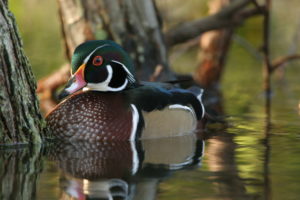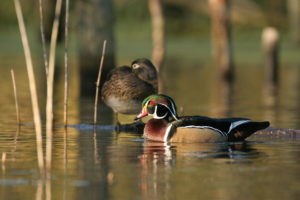Wood Ducks: A Cautionary Tale With A Happy Ending?
Photo Below: The Wood Duck is one of the most beautiful birds but has suffered great population losses due to market hunting and loss of habitat. Fortunately, government regulations and the actions of private individuals have helped their populations to rebound but threats remain. (Photo courtesy of Chesapeake Wildlife Heritage)

My wife has done a fantastic job managing our property on Maryland’s Eastern Shore for wildlife. It is thrilling to see the birds flock to the feeders she has just filled, often with her only a few feet away. Now that spring is finally emerging, bird calls fill the air around the house.
When we walk the 43-acre property we never know what we will encounter — Barred Owls (heard more often than seen), Wood Cock (even while shoveling snow), Spadefoot (a type of toad), Luna Moths (frequently after their brief life has ended and all that remains are the wings), and so much more.
On a recent walk, we spotted two Wood Ducks on one of our small wetlands. It was a male and a female. They took note of us quickly, watched us briefly and then took off loudly as their screeches let us know they were not pleased that we wandered by.
Wood Ducks are an excellent example of what humans can do to wildlife — both the bad and the good.
Wood Duck Basics:
Male Wood Ducks are considered one of the most beautiful birds in North America. The scientific name is Aix sponsa which translates along the lines of “waterbird in bridal dress.” Although the females are duller, the males have brilliant bursts of colors all over their bodies.
Woodies need woodlands near water to survive. This can include bottomland hardwood wetlands, beaver ponds, river oxbows and more. They nest in tree cavities — an unusual habit for waterfowl. Some of these cavities can be as high as 65 feet high. Females will typically lay 9-14 eggs per nest.

A male and female Wood Duck enjoy a restored wetland on a property owned by a private individual. This person’s dedication to wildlife conservation led to the restoration of 100 acres of wetlands on Maryland’s Eastern Shore. The restored wetland provides habitat for wildlife and improves water quality in the Chesapeake Bay. And the Wood Ducks love it! (Photo courtesy of Chesapeake Wildlife Heritage)
The young will leave the nest within 24 hours. One brood of Wood Ducks was observed jumping 7 feet to the ground, walking down a bluff and across a railroad track before reaching water. But they were not done — this day-old brood followed their mother ¾ of mile across the river to a bottomland forest that provided a good feeding grounds.
Also by Chris Pupke, Wildlife Friendly Fencing
Wood Ducks — Bust and Boom:
Wood Ducks were common in the United States during the colonial period. However, by the late 19th century, their population had crashed. Many people feared that Wood Ducks would become extinct. What caused such a dramatic population collapse? Market hunting and habitat destruction.
Market hunting is commercial hunting. This type of hunting was especially effective at killing birds in huge numbers. It helped cause the extinction of several species of birds. Wood Ducks were hunted for meat to feed families and feathers for fancy hats (as well as pillows and mattresses).
Logging and draining of wetlands also impacted Wood Duck populations. Wood Ducks need mature woodlands with trees that have cavities to breed. When wooded wetlands were logged or drained, Wood Ducks lost habitat.
In 1901, ornithologist George Bird Grinnell wrote that Wood Ducks “are becoming very scarce and are likely to be exterminated before long.” With this bleak future, what saved the Wood Duck?
Regulation and Compassion:
The Migratory Bird of Act of 1918 was one of the most important pieces of environmental legislation ever passed by the US Congress. It regulated hunting for a host of birds, including the Wood Duck. From 1918 to 1941, hunting Wood Ducks was banned. This moratorium gave Wood Ducks refuge from one their most significant threats.
But Woodies needed more than a hunting ban. They needed improved habitat conditions for breeding, especially nesting cavities. With the slow advancement of wetland protection, Wood Ducks still faced a significant threat. Fortunately, they adapted readily to using nest boxes. These man-made boxes replicate the natural cavities found in old trees.
Art Hawkins, a former student of Aldo Leopold, helped develop the design of Wood Duck boxes in the 1930’s and was a major advocate for their wide-spread adoption. One of Hawkins’ major supporters in this effort Leopold’s brother Frederic.
Additionally, wetland restoration is being undertaken by landowners throughout the Wood Duck’s range. Wetland restoration provides critical habitat for Woodies and a host of other wildlife species. Without private landowners working to restore and protect Wood Duck habitat, their populations would continue to struggle.
Related Article: Nesting Boxes: Nests, Eggs, Chicks & Surprises
The Situation Today:
The International Union for Conservation of Nature lists the Wood Duck population as increasing and Wood Ducks are a species of ‘least concern’. This is quite a turnaround for a species that was once almost lost — a turnaround that was only made possible through government regulation and individuals taking action to support this beautiful bird.
But today a new threat is emerging for the Wood Duck. The EPA is attacking environmental regulations and its Administrator Scott Pruitt seems bent on eliminating protections for wooded wetlands that provide the valuable habitat that Wood Ducks need to survive.
Unfortunately, Wood Ducks continue to face threats. But we have proven in the past that these threats can be addressed, and we can have a positive impact for wildlife.
You can have a positive impact for Wood Ducks and other wildlife by restoring habitat on your property, installing and monitoring nesting boxes, advocating for stronger environmental regulations that protect existing habitat and supporting conservation organizations that are dedicated to wildlife conservation.
The question remains, however: What will your role be when the tale of the Wood Duck is written?
Sources:
Gill, Frank B. “Ornithology”; W.H. Freeman & Co.; New York, NY; 1995.
Grinnell, George B.; “On American Duck Shooting”; Forest and Stream Publishing Company; 1901.
Robbins, Chandler, editor; “Atlas of Breeding Birds of Maryland and the District of Columbia”; University of Pittsburgh Press, Pittsburgh, PA; 1996.
Wood Duck: Aix Sponsa; US Department of Agriculture; Natural Resources Conservation Service, Wildlife Habitat Management Institute; Madison, MS.
http://www.audubon.org/field-guide/bird/wood-duck
http://www.iucnredlist.org/details/22680104/0
http://www.leopoldlandscape.org/index.php/conservation/wood-ducks/

Recent Comments